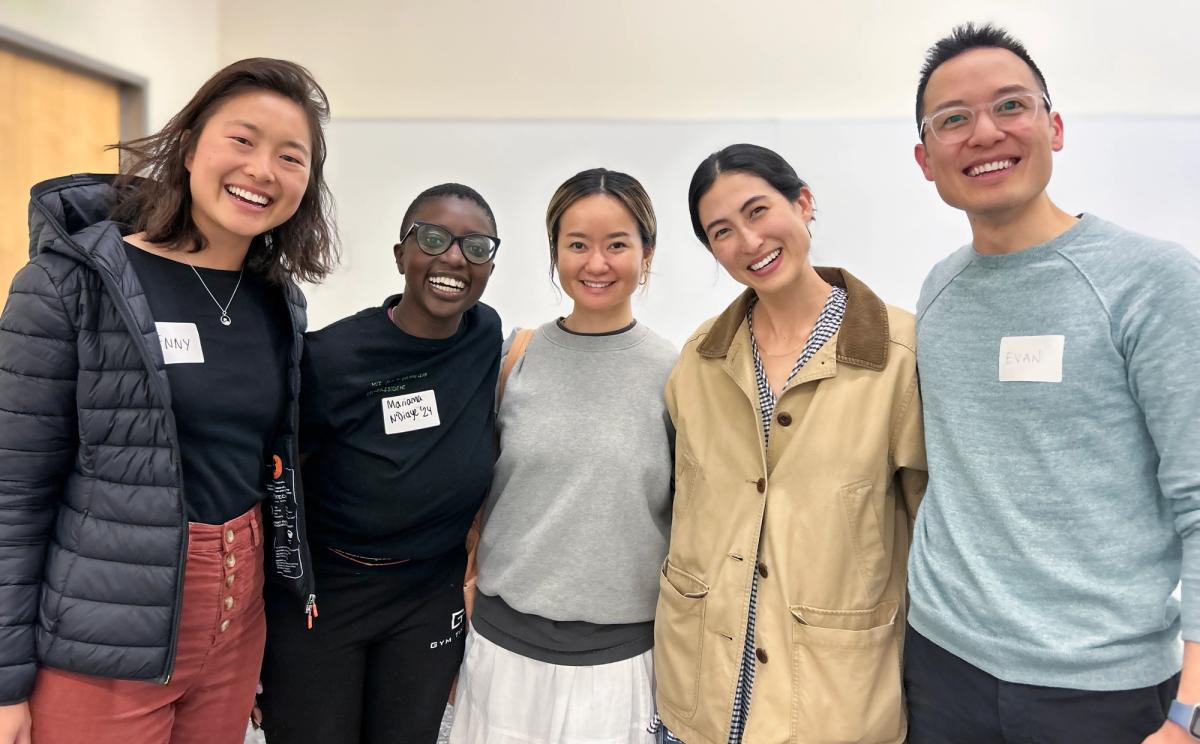Putting User Needs on the Map
MIT Sloan Design Club and Evan Chan bring Human-Centered Design to the Community
In a collaborative workshop, participants learn to transform an interview and sticky notes into journey maps, a communicative tool of human-centered design.
By Michelle Luo
Apr 26, 2024
Over forty attendees from MIT and the public joined the MIT Sloan Design Club and guest designer Evan Chan, founder and director of the Human-Centered Design (HCD) Lab, in the workshop “User Journeys” on April 8. In this first collaboration, Chan introduced journey mapping, a visualization tool in human-centered design which traces the experience of a person using steps, phases, and emotional peaks and valleys of a process.

For the main activity of the evening, groups developed a “current state” journey map which charts a person’s current — often flawed — experience using sticky notes and large paper charts.
Image courtesy of Sloan Design Club
Defining key terms, Chan differentiated HCD from similar fields like user experience and design thinking. In particular, HCD begins with understanding the needs of people experiencing a problem to be addressed — where journey mapping proves useful.
Participants with a shared interest in HCD came together in small groups and mingled over dinner. For the main activity of the evening, groups developed a “current state” journey map which charts a person’s current — often flawed — experience using sticky notes and large paper charts. The first step in developing the journey map is to hear from a user directly, taking detailed notes and quotes. In a live mock interview with Chan, Sloan Design Club Vice President Marissa Cui retold her rocky experience moving from New York to Cambridge. Cui scoped the extent of her moving process from the moment she decided to attend MIT Sloan to when she unpacked the last box.“Moving sucks!” says Cui, anticipating the move and dealing with delays from her movers. But by the end of the move, the gift basket that her family dropped off lifted her spirits.
In this exercise, Cui portrayed a user while Chan modeled insightful interviewing as an HCD designer. From their notes, participants broke out into groups and mapped out the scenario from beginning to end, enumerating steps, grouping steps into phases, and mapping emotions to steps using sticky notes, a useful material because of their ability to be placed and moved around as individuals chimed in to fill gaps, offer new ideas, and pose questions to their groups in service of a shared learning effort. Each group enriched its journey map with numerous details gained from a brief interview, lighting the room abuzz with discussion.

Over forty attendees from MIT and the public joined the MIT Sloan Design Club and guest designer Evan Chan, founder and director of the Human-Centered Design (HCD) Lab, in the workshop “User Journeys” on April 8.
Photo courtesy of the Sloan Design Club
In an extension of the activity, participants ideated “lanes,” additional rows of the journey map that track useful information, depending on the audience or goals of the map. Lanes could include notable pain points, key dates, or time taken to complete a step.
In a final reflection and Q&A, a participant noted the challenge in detaching one’s own biases and predispositions during the journey mapping process. Foregrounding the importance of centering the end user’s needs, Chan advised taking careful notes and conducting multiple interviews, which can lead to the formulation of “archetypes,” another HCD tool that helps consider common user experiences.
At the same time, Chan emphasized the importance of “outliers” or “extreme users” — who are characterized by having the opposite experience of most users — as they can illuminate unique needs and gaps to be filled. Following the completion of a current state journey map, a designer could create a “future state” journey map to help envision and communicate a better experience.

For the Sloan Design Club, students benefit from access to design education in order to “connect with others, broaden their understanding of design, and develop tangible design-related skills.”
Photo courtesy of the Sloan Design Club
MIT Sloan Design Club leaders Marissa Cui, Becca Sandercock, 2022 Design Fellow Mariama N’diaye, and 2023 Fellow Jenny Cang co-organized the event. N’diaye and Cang serve as co-presidents of the MIT Sloan Design Club, leading the organization’s vision. Cui and Sandercock are incoming co-presidents and currently serve to publicize and facilitate events such as “User Journeys” and future hands-on workshops.
“As part of our mission, we have strived to bring design-based knowledge to MIT Sloan, which is unfortunately not available within the Sloan community,” say Sloan Design Club leaders. They highlight that students benefit from access to design education in order to “connect with others, broaden their understanding of design, and develop tangible design-related skills.” They add:

Through their programming, the MIT Sloan Design Club aims “to bridge the gap between the Sloan students curious in design and the greater MIT design ecosystem.
Photo courtesy of the Sloan Design Club
As a human-centered designer and director of the Human-Centered Design Lab (HCD Lab), Chan works to facilitate conversation and collaboration for better design, bringing his experience from government and business contexts to MIT.
Feedback from “User Journeys” attendees highlighted the dynamic and interactive learning experience facilitated by Chan. Kicking off his work as director of the HCD Lab by collaborating with the Sloan Design Club, Chan aims to help foster space for community-building around HCD, which he identifies as an “unmet need” in the Greater Boston area.
Related News
Related Events

DRS2024 BOSTON

The Power of Design

